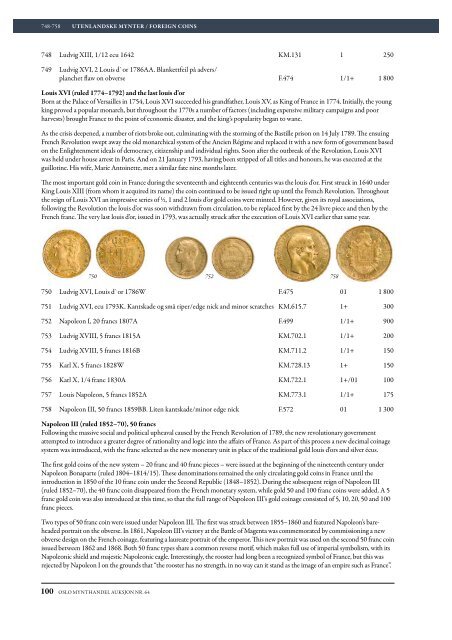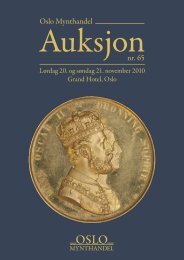Uten navn - Simpleweb AS
Uten navn - Simpleweb AS
Uten navn - Simpleweb AS
You also want an ePaper? Increase the reach of your titles
YUMPU automatically turns print PDFs into web optimized ePapers that Google loves.
748-758<br />
UTENLANDSKE MYNTER / FOREIGN COINS<br />
748 Ludvig XIII, 1/12 ecu 1642 KM.131 1 250<br />
749 Ludvig XVI, 2 Louis d`or 1786AA. Blankettfeil på advers/<br />
planchet aw on obverse F.474 1/1+ 1 800<br />
Louis XVI (ruled 1774–1792) and the last louis d’or<br />
Born at the Palace of Versailles in 1754, Louis XVI succeeded his grandfather, Louis XV, as King of France in 1774. Initially, the young<br />
king proved a popular monarch, but throughout the 1770s a number of factors (including expensive military campaigns and poor<br />
harvests) brought France to the point of economic disaster, and the king’s popularity began to wane.<br />
As the crisis deepened, a number of riots broke out, culminating with the storming of the Bastille prison on 14 July 1789. e ensuing<br />
French Revolution swept away the old monarchical system of the Ancien Régime and replaced it with a new form of government based<br />
on the Enlightenment ideals of democracy, citizenship and individual rights. Soon aer the outbreak of the Revolution, Louis XVI<br />
was held under house arrest in Paris. And on 21 January 1793, having been stripped of all titles and honours, he was executed at the<br />
guillotine. His wife, Marie Antoinette, met a similar fate nine months later.<br />
e most important gold coin in France during the seventeenth and eighteenth centuries was the louis d’or. First struck in 1640 under<br />
King Louis XIII (from whom it acquired its name) the coin continued to be issued right up until the French Revolution. roughout<br />
the reign of Louis XVI an impressive series of ½, 1 and 2 louis d’or gold coins were minted. However, given its royal associations,<br />
following the Revolution the louis d’or was soon withdrawn from circulation, to be replaced rst by the 24 livre piece and then by the<br />
French franc. e very last louis d’or, issued in 1793, was actually struck aer the execution of Louis XVI earlier that same year.<br />
750 752 758<br />
750 Ludvig XVI, Louis d`or 1786W F.475 01 1 800<br />
751 Ludvig XVI, ecu 1793K. Kantskade og små riper/edge nick and minor scratches KM.615.7 1+ 300<br />
752 Napoleon I, 20 francs 1807A F.499 1/1+ 900<br />
753 Ludvig XVIII, 5 francs 1815A KM.702.1 1/1+ 200<br />
754 Ludvig XVIII, 5 francs 1816B KM.711.2 1/1+ 150<br />
755 Karl X, 5 francs 1828W KM.728.13 1+ 150<br />
756 Karl X, 1/4 franc 1830A KM.722.1 1+/01 100<br />
757 Louis Napoleon, 5 francs 1852A KM.773.1 1/1+ 175<br />
758 Napoleon III, 50 francs 1859BB. Liten kantskade/minor edge nick F.572 01 1 300<br />
Napoleon III (ruled 1852–70), 50 francs<br />
Following the massive social and political upheaval caused by the French Revolution of 1789, the new revolutionary government<br />
attempted to introduce a greater degree of rationality and logic into the aairs of France. As part of this process a new decimal coinage<br />
system was introduced, with the franc selected as the new monetary unit in place of the traditional gold louis d’ors and silver écus.<br />
e rst gold coins of the new system – 20 franc and 40 franc pieces – were issued at the beginning of the nineteenth century under<br />
Napoleon Bonaparte (ruled 1804–1814/15). ese denominations remained the only circulating gold coins in France until the<br />
introduction in 1850 of the 10 franc coin under the Second Republic (1848–1852). During the subsequent reign of Napoleon III<br />
(ruled 1852–70), the 40 franc coin disappeared from the French monetary system, while gold 50 and 100 franc coins were added. A 5<br />
franc gold coin was also introduced at this time, so that the full range of Napoleon III’s gold coinage consisted of 5, 10, 20, 50 and 100<br />
franc pieces.<br />
Two types of 50 franc coin were issued under Napoleon III. e rst was struck between 1855–1860 and featured Napoleon’s bareheaded<br />
portrait on the obverse. In 1861, Napoleon III’s victory at the Battle of Magenta was commemorated by commissioning a new<br />
obverse design on the French coinage, featuring a laureate portrait of the emperor. is new portrait was used on the second 50 franc coin<br />
issued between 1862 and 1868. Both 50 franc types share a common reverse motif, which makes full use of imperial symbolism, with its<br />
Napoleonic shield and majestic Napoleonic eagle. Interestingly, the rooster had long been a recognized symbol of France, but this was<br />
rejected by Napoleon I on the grounds that “the rooster has no strength, in no way can it stand as the image of an empire such as France”.<br />
100 OSLO MYNTHANDEL AUKSJON NR. 64



